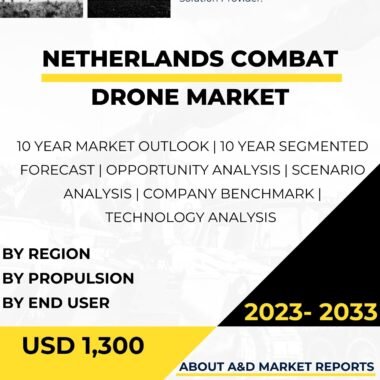Description
The combat drone market in France is a crucial and rapidly expanding segment of the country’s defense industry, playing a significant role in bolstering its military capabilities and addressing the evolving security challenges of the 21st century. As a major player in the global arms market, France has been actively involved in the research, development, and production of advanced combat drones to meet the growing demand for unmanned aerial systems (UAS) and enhance its military effectiveness. This essay provides an overview of France’s combat drone market, focusing on its significance, key players, technology advancements, applications, international collaborations, policy considerations, and future prospects.
The significance of France’s combat drone market lies in its role as a critical enabler of modern warfare. Combat drones, also known as unmanned combat aerial vehicles (UCAVs), are unmanned aircraft designed to carry out various military missions, including intelligence, surveillance, reconnaissance (ISR), and precision strikes. These systems provide French forces with enhanced situational awareness, extended operational reach, and reduced risks to personnel, making them a crucial asset in addressing contemporary security challenges.
Key players in France’s combat drone market include government entities, defense companies, and research institutions. The French Ministry of Armed Forces, through its procurement agency, the Direction G?n?rale de l’Armement (DGA), plays a central role in overseeing the acquisition and development of combat drones for the country’s armed forces. Additionally, private defense companies like Dassault Aviation, Thales, and Safran have been instrumental in the research, development, and production of advanced combat drone systems.
Technological advancements have been pivotal in shaping the growth of France’s combat drone market. Innovations in sensor technology, artificial intelligence, autonomy, and communication systems have significantly improved the capabilities of combat drones. Advanced sensors and cameras provide high-resolution imagery for intelligence gathering, while AI and machine learning algorithms enable autonomous flight and mission planning, reducing the need for constant operator intervention.
The applications of combat drones in France are diverse and critical for various military operations. One of the primary applications is in intelligence, surveillance, and reconnaissance (ISR) missions. Combat drones equipped with advanced sensors and cameras can conduct long-endurance surveillance operations, monitor border areas, and provide real-time intelligence to military commanders.
Furthermore, combat drones play a crucial role in precision strikes. Armed UCAVs carry a variety of munitions, including missiles and guided bombs, enabling them to conduct targeted strikes on enemy assets with high precision and reduced collateral damage.
In addition to their combat capabilities, combat drones are used for electronic warfare (EW) operations, such as jamming enemy communications or detecting and neutralizing enemy radars. Their ability to operate in contested environments without risking human lives makes them ideal for such roles.
France’s combat drone market has also benefited from strategic international collaborations. The country has engaged in partnerships with other nations and defense industries to share technological expertise, collaborate on joint research and development programs, and facilitate the exchange of knowledge and resources. Such collaborations have strengthened France’s defense relationships and expanded the market reach for its combat drone technologies.
Policy considerations play a significant role in shaping France’s combat drone market. The country adheres to international regulations and arms control treaties concerning the use and export of UAS and armed drones. Additionally, national policies prioritize the development and deployment of advanced combat drones to enhance military capabilities and protect French interests both at home and abroad.
Looking ahead, the future prospects of France’s combat drone market are promising. As the security landscape continues to evolve, combat drones are expected to play an increasingly critical role in military operations. The demand for advanced UCAVs with improved sensor capabilities, longer endurance, and greater autonomy is likely to grow.
However, challenges remain for the market. One such challenge is the need for continuous research and development to stay ahead of evolving technologies and address potential threats, such as counter-drone measures. As adversaries develop countermeasures to neutralize combat drones, France must invest in cutting-edge research to maintain its position as a leader in the global combat drone market.
Moreover, ensuring interoperability and seamless integration of combat drones with existing military assets is crucial to maximize their effectiveness. Streamlining development processes and optimizing command and control systems are essential to meet the demands of both domestic and international customers.
To address these challenges and seize opportunities, France’s combat drone market must focus on continuous innovation and collaboration. Emphasizing the integration of advanced sensors, AI, and communication systems will enable the production of more efficient and effective combat drones.
In conclusion, France’s combat drone market is a critical component of its defense industry, providing essential capabilities for modern military operations. Key players, technology advancements, applications, international collaborations, policy considerations, and future prospects all contribute to the market’s significance. The future prospects of the market are promising, driven by the increasing demand for advanced combat drones to enhance military effectiveness and maintain France’s position as a technologically advanced military power. By maintaining its focus on innovation, quality, and international cooperation, France can continue to strengthen its position in the global combat drone market.




